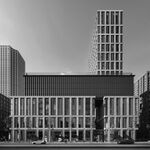Urban Toronto has partnered with Heritage Toronto to capture a moment in Toronto's past. On a weekly basis, we highlight historic photos of the city's people, places and events, and tell the stories behind them.
A hundred years ago, before the days of infection control, Toronto was plagued by numerous diseases, among them small pox which ravaged Toronto in the 1870s and for some 20 years after. Back then, there were few options for people who were infectious, so the City decided to create an isolation hospital.
 Riverdale Isolation Hospital, 1907
Riverdale Isolation Hospital, 1907
The government looked for a site that was remote from Toronto and located land on the east side of the Don River near from the Don Jail. Not far from Gerrard was the House of Refuge built for “incurables, incapables and indigent poor.” In 1872 it was transformed into what became known simply as “the Isolation Hospital.” Here, people with numerous diseases were cared for including tuberculosis, scarlet fever, and small pox.
Over time, the hospital became a leader in the treatment of infectious diseases and took on a new name, Riverdale Isolation Hospital. Also the facility expanded to include a number of buildings that were designated to care for patients with different diseases. Among them was the “Swiss Cottage” seen in this photo around 1907 located off Winchester Street. With 25 beds, it had perhaps more of an exterior appearance of a home than what we traditionally think of as a hospital. Built in 1901, people came to the Swiss Cottage for treatment exclusively relating to Small Pox. It went into disuse in the 1920's and burned to the ground in 1930.
Eventually, the Riverdale Isolation Hospital became known as Riverdale Hospital and later evolved into Bridgepoint Health.
Sources:
http://www.toronto.ca/archives/public-health/hospitals.htm
http://www.bridgepointhealth.ca/history
Many thanks to both Gary Switzer of MOD Developments and Maya Bilbao for putting together the photos and research.


 3.3K
3.3K 







































